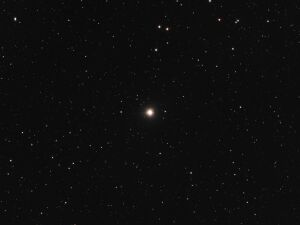Astronomy:Xi Herculis
| Observation data Equinox J2000.0]] (ICRS) | |
|---|---|
| Constellation | Hercules |
| Right ascension | 17h 57m 45.88571s[1] |
| Declination | +29° 14′ 52.3675″[1] |
| Apparent magnitude (V) | 3.70[2] |
| Characteristics | |
| Spectral type | G8 III[3] |
| U−B color index | +0.66[2] |
| B−V color index | +0.93[2] |
| Astrometry | |
| Radial velocity (Rv) | −1.65±0.17[4] km/s |
| Proper motion (μ) | RA: +82.44[1] mas/yr Dec.: −18.73[1] mas/yr |
| Parallax (π) | 23.84 ± 0.15[1] mas |
| Distance | 136.8 ± 0.9 ly (41.9 ± 0.3 pc) |
| Absolute magnitude (MV) | +0.62[5] |
| Details | |
| Mass | 2.01[6] M☉ |
| Radius | 10[4] R☉ |
| Luminosity | 51[4] L☉ |
| Surface gravity (log g) | 2.87±0.09[7] cgs |
| Temperature | 4,966±15[4] K |
| Metallicity [Fe/H] | +0.09±0.04[7] dex |
| Rotation | 67[8] d |
| Rotational velocity (v sin i) | 2.8[4] km/s |
| Age | 2.48[6] Gyr |
| Other designations | |
| Database references | |
| SIMBAD | data |
Xi Herculis is a solitary[10] star located within the northern constellation of Hercules. The star is visible to the naked eye with an apparent visual magnitude of 3.70.[2] Based upon an annual parallax shift of 23.84 mas as seen from Earth, it is located 137 light years from the Sun. At that distance, the visual magnitude of the star is diminished by an extinction factor of 0.05 due to interstellar dust. It is a suspected member of the Sirius stream of co-moving stars.[11]
This is an evolved G-type giant star with a stellar classification of G8 III.[3] It is a red clump star, which means it is on the horizontal branch and generating energy through the thermonuclear fusion of hydrogen at its core. The star is emitting X-rays with a luminosity of 3.03×1030 erg s−1 in the 0.3–10 keV band.[8] It has twice[6] the mass of the Sun but, at the age of two and a half billion years,[6] it has expanded to 10[4] times the Sun's radius. The star is radiating 51[4] times the solar luminosity from its photosphere at an effective temperature of 4,966 K.[4]
Xi Herculis is a semiregular variable star, oscillating in brightness by 3 hundredths of a magnitude, over a period of 120.8 days.[13]
Chinese name
In R.H.Allen's book Star Names: Their Lore and Meaning, this star, together with ν Her and 99 Her (b Herculis) represent the state of Zhongshan (or Chung Shan' "the Middle Mountain"),[14] but in Chinese literature, that names is applied to ο Her.[15]
Markov 1, the mini teapot
One third of a degree to the north-northwest of Xi Herculis is the location of a telescopic asterism in the shape of a teapot. This teapot (Markov 1) could be seen as a somewhat twisted small equivalent of the large and easy to recognize teapot asterism in the constellation Sagittarius.
References
- ↑ 1.0 1.1 1.2 1.3 1.4 van Leeuwen, F. (2007), "Validation of the new Hipparcos reduction", Astronomy and Astrophysics 474 (2): 653–664, doi:10.1051/0004-6361:20078357, Bibcode: 2007A&A...474..653V.
- ↑ 2.0 2.1 2.2 2.3 Mermilliod, J.-C. (1986), "Compilation of Eggen's UBV data, transformed to UBV (unpublished)", Catalogue of Eggen's UBV Data (SIMBAD), Bibcode: 1986EgUBV........0M.
- ↑ 3.0 3.1 Morgan, W. W.; Keenan, P. C. (1973), "Spectral Classification", Annual Review of Astronomy and Astrophysics 11: 29, doi:10.1146/annurev.aa.11.090173.000333, Bibcode: 1973ARA&A..11...29M.
- ↑ 4.0 4.1 4.2 4.3 4.4 4.5 4.6 4.7 Massarotti, Alessandro et al. (January 2008), "Rotational and Radial Velocities for a Sample of 761 HIPPARCOS Giants and the Role of Binarity", The Astronomical Journal 135 (1): 209–231, doi:10.1088/0004-6256/135/1/209, Bibcode: 2008AJ....135..209M.
- ↑ Böhm-Vitense, Erika et al. (December 2000), "Ultraviolet Emission Lines in BA and Non-BA Giants", The Astrophysical Journal 545 (2): 992–999, doi:10.1086/317850, Bibcode: 2000ApJ...545..992B.
- ↑ 6.0 6.1 6.2 6.3 Luck, R. Earle (September 2015), "Abundances in the Local Region. I. G and K Giants", The Astronomical Journal 150 (3): 23, doi:10.1088/0004-6256/150/3/88, 88, Bibcode: 2015AJ....150...88L.
- ↑ 7.0 7.1 Prugniel, Ph. et al. (July 2011), "The atmospheric parameters and spectral interpolator for the MILES stars", Astronomy & Astrophysics 531: A165, doi:10.1051/0004-6361/201116769, Bibcode: 2011A&A...531A.165P.
- ↑ 8.0 8.1 Gondoin, P. (December 2005), "The relation between X-ray activity and rotation in intermediate-mass G giants", Astronomy and Astrophysics 444 (2): 531–538, doi:10.1051/0004-6361:20053567, Bibcode: 2005A&A...444..531G.
- ↑ "ksi Her". SIMBAD. Centre de données astronomiques de Strasbourg. http://simbad.u-strasbg.fr/simbad/sim-basic?Ident=ksi+Her.
- ↑ Eggleton, P. P.; Tokovinin, A. A. (September 2008), "A catalogue of multiplicity among bright stellar systems", Monthly Notices of the Royal Astronomical Society 389 (2): 869–879, doi:10.1111/j.1365-2966.2008.13596.x, Bibcode: 2008MNRAS.389..869E.
- ↑ Famaey, B. et al. (January 2005), "Local kinematics of K and M giants from CORAVEL/Hipparcos/Tycho-2 data. Revisiting the concept of superclusters", Astronomy and Astrophysics 430 (1): 165–186, doi:10.1051/0004-6361:20041272, Bibcode: 2005A&A...430..165F.
- ↑ "/ftp/cats/more/HIP/cdroms/cats". Strasbourg astronomical Data Center. https://cdsarc.cds.unistra.fr/viz-bin/ftp-index?/ftp/cats/more/HIP/cdroms/cats.
- ↑ "ksi Her". AAVSO. https://www.aavso.org/vsx/index.php?view=detail.top&oid=15893.
- ↑ Allen, R. H. (1963), Star Names, Their Lore and Meaning, Dover, p. 246, https://penelope.uchicago.edu/Thayer/E/Gazetteer/Topics/astronomy/_Texts/secondary/ALLSTA/Hercules*.html, retrieved 2017-04-11.
- ↑ (in Chinese) AEEA (Activities of Exhibition and Education in Astronomy) 天文教育資訊網 2006 年 6 月 6 日
 |



